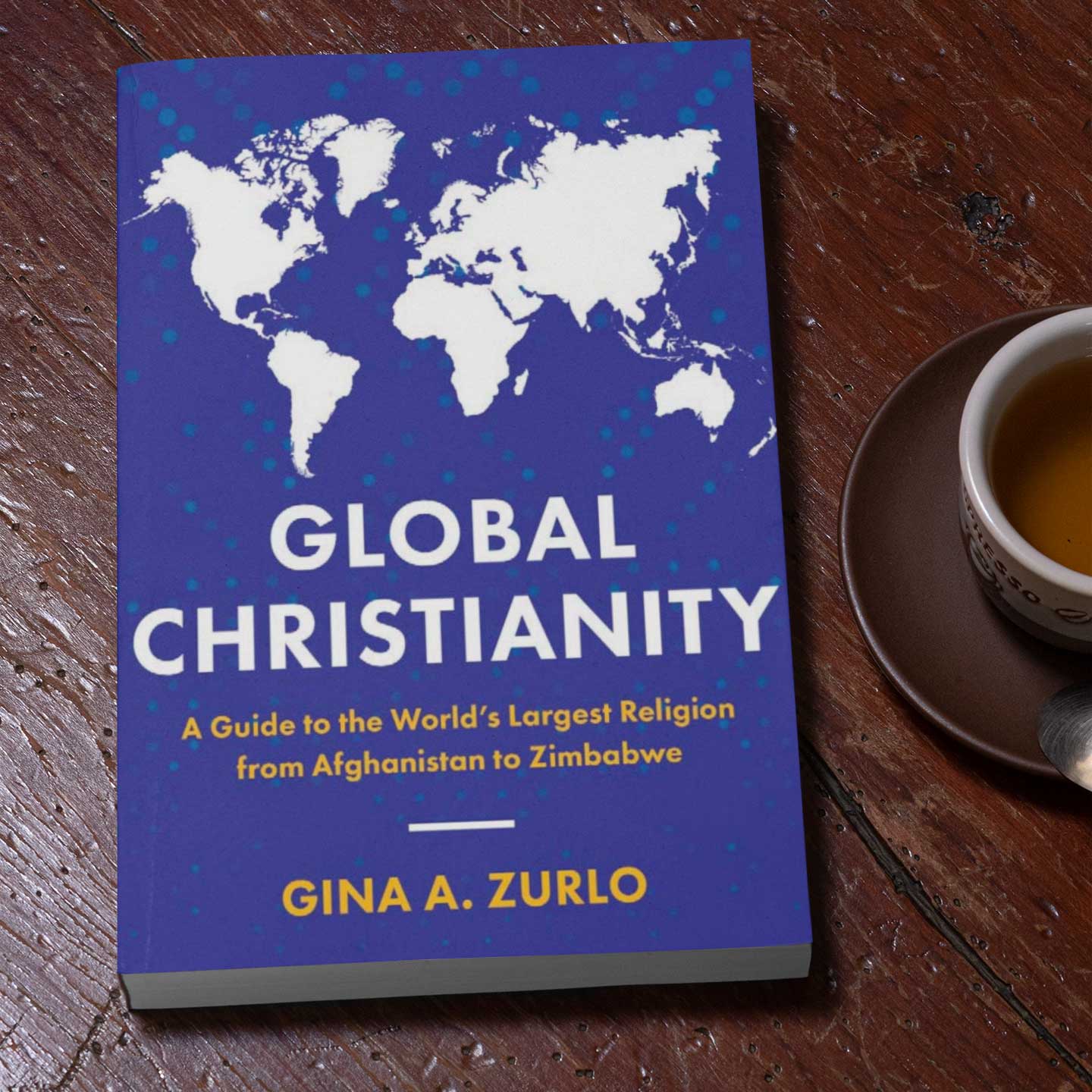Book
Global Christianity: A Guide to the World’s Largest Religion from Afghanistan to Zimbabwe
Gina Zurlo sets the table with a banquet of statistics that will energize thanksgiving and prayer for global Christians.
Around the year 200 AD, a young mother named Perpetua was asked, ‘Who are you?’ She answered, ‘I am a Christian’ and then met martyrdom in the arena.
How many people in the world today would answer similarly?
This is the question Gina Zurlo and the researchers at the Center for the Study of Global Christianity investigate in Global Christianity: A Guide to the World’s Largest Religion from Afghanistan to Zimbabwe (Zondervan, 2022, $30).
Gordon-Conwell Theological Seminary’s Center for the Study of Global Christianity produces an annual one-page summary of global Christian statistics that has become the go-to reference for top line numbers around the world. And while the recent editions of the World Christian Encyclopedia (3rd ed., 2019) and the online World Christian Database (2018) provide exhaustive statistics, the high prices limit availability to institutional subscribers.
Enter this slim volume. No country receives more than three pages, and many small nations receive only half a page, so that the book provides a snapshot of Christianity in every country. As a quick desk reference to statistics and analysis, this volume is indispensable. And if the similar format for each country feels repetitive in a straight read-through, the emerging patterns of Christian growth and decline help cement in one’s mind the dominant features of each region of the world.
How to Use this Book
Evangelical authors will immediately compare this book to Jason Mandryk’s Operation World (2010), now in its 7th edition. Operation World is a prayer guide, whereas Global Christianity is a fact book. The first directs the church toward evangelism and mission, while the second leads toward prayer for the church as in Ephesians 6:18, which says, ‘keep alert with all perseverance, making supplication for all the saints’ (emphasis added). And while Zurlo does not give us explicit prayer points, the ‘Facts to Consider’ section functions in much the same way.
The single greatest feature of this text is the 100-year look-back graphs of Christianity against its greatest rival for religious allegiance in a given country. The competitor could be the ‘nonreligious’, as in Europe, or a world religion such as Buddhism or Islam. The graphs provide stark visual images of the hard realities of Christian presence. In Afghanistan, for example, the Muslim line tracks at 100 percent from 1900 to today, while the Christian line appears no higher than 0 percent (<0.5 percent).
The graphs also demonstrate the transformation of many societies since 1900. Many southern African countries that were 95 percent affiliated with traditional African religion in 1900 are greater than 95 percent Christian today. At the same time, some countries north of the 12th parallel show a similarly dramatic rise in Islam at the expense of traditional religions (eg Guinea, Mali, Niger).
Second, Global Christianity teaches about the recurring patterns of religious affiliation around the world—whether it’s the twentieth-century blossoming of Christianity in Africa or the 75/25 split of Catholics to Protestants in Latin America. The secularization of Europe is clearly visible through the rise of the ‘nonreligious’. Christian and nonreligious affiliation frequently match each other for these countries, either in 2020 or as projected for 2050. The decline and return of religious affiliation in post-Soviet nations becomes clear after the same pattern is repeated throughout Eurasia. The remarkable acceptance of Christianity among the Pacific Island nations comes out strikingly.
Third, for use as a prayer tool, Global Christianity helpfully includes one-sentence predictions about the prospects of Christianity in a country and graphs that estimate religious affiliation in 2050. It is not uncommon to find statements such as, ‘Islam is the largest religion [in Azerbaijan] and will likely remain [so] in the future (97% in 2020)’ (50).
The book will serve as its own witness come 2050, and in certain respects, would it not be amazing to have it proven wrong? The statistical analysis and tentative predictions are entirely appropriate, but the praying Christian can hope that God may have something different in mind.
For example, a statistical projection about African Christianity in 1900 probably would have missed the incredible growth that occurred in the twentieth century. In the 1930s, mission skeptics such as Pearl Buck believed that Christianity would die in China if the missionaries were forced to leave. Yet the last seventy years have proven the depth of Christian conviction in China and its continuing growth. Global Christianity gives a best guess about the next thirty years of Christian growth, but it also leaves room for prayer that God may surprise us.
Article
Is Christianity Shrinking or Shifting?
Authors Gina Zurlo and Todd M. Johnson explain findings from The World Christian Encylopedia, 3rd Edition.
Statistics and Editorial Decisions
Statistics are always used with a goal in mind, and this book is no exception. Bare tables of data would be uninteresting, so Zurlo provides a narrative overview of the history and contemporary situation in each country. In addition, she highlights several ‘Facts to Consider’ which, in the nature of the case, sometimes seem to reflect the interests of the author. I point out one difficult editorial decision and one way in which I find the use of data to be somewhat misleading.
Global Christianity bases its numbers on self-identification. This means that Latter-Day Saints (Mormons) and Jehovah’s Witnesses are included under the Christian affiliation as ‘Independents’, similar to African Independent Churches (AIC) that claim no direct link to historic Christian denominations. Non-affiliated charismatic churches and even schisms from Eastern Orthodoxy are included in the same ‘Independents’ family, even though these movements affirm historic Christian orthodoxy. Latter-Day Saints and Jehovah’s Witnesses were founded and developed as alternatives to the predominant Christian faiths in their nineteenth-century context and are viewed with skepticism by almost all other Christian confessions. Operational World helpfully lists JWs and Mormons as ‘Marginal’, as distinguished from ‘Independent’ movements.
Within the limits of a survey of global Christianity, I understand the reasons for Zurlo’s decision in this regard. But readers need to keep in mind those differences when they read that Jehovah’s Witnesses are the second-largest denomination in several countries. The ‘Marginal’ category might have been helpful and revealing, especially in countries where those two combined make up more than 5 percent of self-identifying Christians. In seeking to be unbiased, the book ends up deciding that anyone who self-identifies as a Christian can be regarded as such.
Second, Zurlo chooses to highlight issues particularly relevant to women in several entries. Most of these are insightful and helpful. High rates of violence against women, especially in countries that have an overwhelming majority-Christian affiliation, is bracing and leads to earnest prayer. At the same time, Zurlo brings up questions about women in Christian leadership positions that seem to represent only one view.
For instance, she writes, ‘While women make up the majority of Christian congregations around the world, they are frequently excluded from official positions of leadership’ (5). She continues, ‘Women form 13.5% of Protestant clergy in the USA, despite that 72% of people believe women should be allowed to preach’ (15). These sentences imply that because women make up a majority of Christian congregations, and because most Americans believe women should ‘be allowed to preach’, there ought to be a higher percentage of women in church leadership positions in the United States. The use of statistics does not, however, provide adequate nuance for the reasons this issue is debated among Christians. The number of women in church leadership positions, for many Christian communities, reflects exegetical and theological decisions that go unarticulated in the juxtaposing of statistics.
Praise and Prayer
If we want to know how many people would confess today, ‘I am a Christian’, this book is the place to begin. As statisticians, Christians have come a long way from William Carey’s tentative estimates about the populations of China and India in his Enquiry (1792) that catalyzed the modern missions movement. We have great reason to be thankful for this labor. The diachronic glance at Christianity in the last 120 years for every country in the world gives any reader a helpful start to asking, ‘What is God doing in that country?’
And, despite the somewhat repetitive structure of an encyclopedia like this, there are surprises to be found on nearly every page: whether the specialist knowledge that Guyana in South America is made up of 25 percent Hindus, or the sobering note that ‘the first and only Protestant church building [in Mauritania] was consecrated in Nouakchott in December 2018’ (195), or that the Netherlands identified as 30 percent evangelical in 1900, but is a mere 3 percent evangelical today (212), or, more optimistically, the incredible ‘missionaries sent’ numbers from Brazil (40,000), Nigeria (20,000), and South Korea (35,000).
Global Christianity sets the table with a banquet of statistics that will energize thanksgiving and prayer for Christians around the world.



